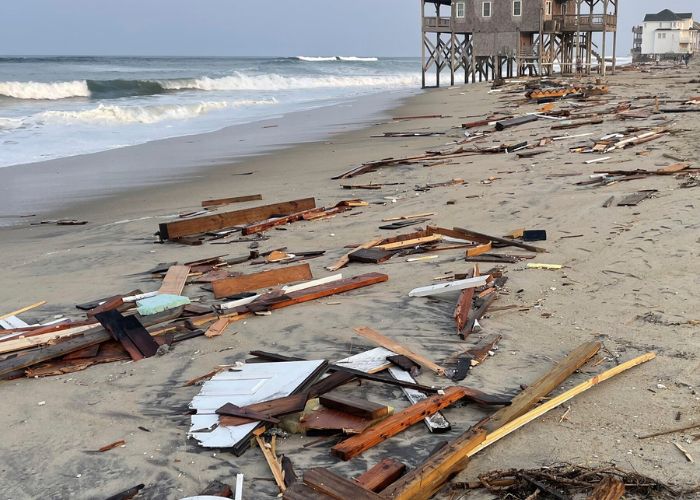As a resident of the Outer Banks for over 7 years now, it pains me to see the continuing erosion and collapse of homes along our treasured coastline. Just this week, a third home fell into the Atlantic Ocean, as powerful waves continue to eat away at the beaches and protective dunes. Let’s read below about “3rd Home Collapse in Outer Banks- North Carolina’s Coastal Crisis Unfolds”.
Table of Contents
The Perils of Coastal Erosion in the Outer Banks
Having lived through many storms and witnessed the aftermath, I understand firsthand how vulnerable much of the Outer Banks is to coastal erosion. Areas like Rodanthe, Salvo and Avon have been hit particularly hard over the years. In fact, I used to have friends who owned homes in the now collapsed area of Ocean Drive in Rodanthe. They were forced to move years ago as the water crept closer and closer.
While beach nourishment projects and dune replenishments have helped mitigate erosion in some areas, it’s clear that more needs to be done. As sea levels rise and storms become more intense with climate change, large sections of NC-12 and entire neighborhoods remain dangerously exposed.
The collapsed homes in Rodanthe highlight the precarious future of the Outer Banks as erosion continues. We’re literally watching houses and infrastructure disappear into the ocean. Just this month, two homes directly next to each other fell into the waves within a span of two weeks. And now a third home on Ocean Drive has met the same fate.
The Domino Effect of Home Collapses

As a local, I’ve seen firsthand how these collapses impact the surrounding homes. After the first two houses fell, the deck on the third house was left dangling over the edge. It was clear the rest of the house wouldn’t be far behind.
Sure enough, a few weeks later, the third home collapsed as waves washed away the supporting land underneath. Now, several other homes in the immediate vicinity appear at risk, as the water creeps closer and closer with each high tide. It’s only a matter of time before more of the neighborhood crumbles.
Seeing places I once knew and loved disappear is heartbreaking. But it’s also a stark reminder that if we don’t take action, we risk losing entire communities. Approximately 1,400 homes along the Outer Banks could be lost to erosion and rising seas over the next 20 years if nothing is done.
And it’s not just homes at stake. NC-12, the only road connecting Hatteras Island to the mainland, is in jeopardy in many spots. Just north of Rodanthe, the highway runs right along the beach and has had to be repaired and relocated several times. Erosion could eventually sever the lifeline to Hatteras Island, where thousands live and visit
As a local resident, I’m doing what I can to advocate for solutions. Living on the Outer Banks means you have to be prepared for hurricanes and erosion. But residents need better options than simply watching their homes disappear.
We need comprehensive beach nourishment and dune restoration to protect vulnerable areas. And in cases where erosion is too severe, government buyout programs should allow homeowners to relocate inland with compensation. Abandoning entire neighborhoods to the rising seas cannot be the only choice.
The Urgent Need for Coastal Protection
I’m encouraged to see more attention being paid to the erosion crisis unfolding on the Outer Banks. Just this month, North Carolina lawmakers approved $20 million in funding to nourish beaches along the coast. And officials are seeking federal money to move NC-12 on Hatteras Island further inland.
These are good starts. But much more funding and support will be needed in the coming years. As a local resident for over 7 years, I’ve seen firsthand how cherished this place is. But I’ve also seen how quickly it can wash away if not cared for properly.
The Outer Banks is a national treasure, offering pristine beaches, maritime forests and wildlife habitats. If we don’t take bold action now, we risk losing entire sections of the islands we know and love. The recent home collapses are just the beginning.
As North Carolina residents, we must urge our leaders to invest in protecting the Outer Banks coastline. Nourishing beaches, restoring dunes, relocating infrastructure and compensating displaced homeowners where necessary. This isn’t just a local issue. The Outer Banks draws over 3 million visitors a year, contributing billions to the state’s economy.
In addition to advocating locally, we need federal support too. The islands have been battered by several hurricanes in recent years. We need funding assistance to rebuild smarter and more resiliently. The National Flood Insurance Program should also offer fairer rates to homeowners committed to protecting their properties.
Conclusion
Having lived through many storms on the Outer Banks, I understand the power of wind and waves. Erosion has always been an issue here. But as climate change accelerates, so does the loss of beach and dunes. I’ve seen beloved coastal homes and businesses disappear firsthand. And more will inevitably follow if we don’t act.
The time is now to come together and protect the Outer Banks for future generations. These barrier islands are worth fighting for. If you’ve ever experienced the breathtaking beaches, windswept dunes and maritime forests, you understand why this place is so special. Let’s urge action before it’s too late.hy this place is so special. Let’s urge action before it’s too late. I hope you get all information of “3rd Home Collapse in Outer Banks- North Carolina’s Coastal Crisis Unfolds”.

ILOCANO + TRAVELER + BLOGGER + ENTREPRENEUR
With over 8 years of global travel experience and a Master’s degree in Travel Journalism, our author brings a blend of academic expertise and real-world exploration to ByAJayRo.com. Passionate about discovering unique destinations and sharing insider tips, they provide practical advice and authentic insights to enhance your travel experiences.
Connect with us on social media for the latest travel updates and inspiration:

